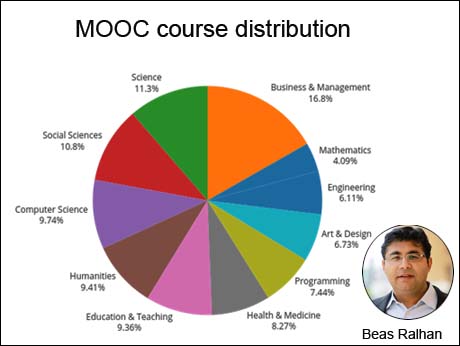
By Beas Dev Ralhan, CEO, Next Education India Pvt. Ltd
September 12 2016: Digitization has taken a huge leap across industries -- from education to online shopping, ordering food, net banking and much more. Digitization in education particularly has broadened the concept of learning. The 21st century now has the phenomenon of Massive Open Online Course (MOOC), which has emerged as a popular medium of learning. It was first introduced in 2008 and served as a non-degree distance education course. MOOC makes the content, on various topics and subjects, available online for any learner.
With MOOCs, learners have an opportunity to study university-quality courses at a lower cost. Though MOOCs are a non-degree courses, there are a few institutions, which have started offering advanced learning options, certificates and credit preferences at an additional cost. This is an ideal medium for individual learners as they have the liberty to select courses from different institutions. MOOC doesn’t require a fixed location or a system. A user can operate it from any location and any computer. There is no hard and fast rule to maintain attendance. Anyone can get enrolled for free, irrespective of their present educational or professional level. One can even show MOOC as a qualification with the medium of paid verified certificate. This makes the certificate and the course more authentic and adds more value to the resume.
Global trend and Scope in developing countries
MOOC has lot of opportunity in K-12 sector, especially as it provides a structure close to that of tuitions. It helps students master their concepts in subjects like Science, Maths and English. Beyond K- 12, MOOCs’ reach is also estimated to expand in higher education, in vocational studies and in corporate training.
The facts prove that in just few years, MOOCs have seen a massive change, with over one million registrations. Coursera is one of the largest MOOCs’ providers, with over 200 courses in different subjects such as social science, economics, computer, music, business, health and science. Udacity and edX are the other top leading online course providers. These brands have now joined hands with renowned universities across the world like Harvard, Edinburgh, Stanford, Melbourne and Toronto, to work together. A study conducted by the University of UK in 2013 shows the percentage of students from different countries going for MOOCs. They are as follows:
North America 35.2%
Europe 28.2%
Asia 21.4%
South America 8.8%
Africa 3.6%
Oceania 2.8%
Though the amount of participation is more in North America and Europe, there is a rising demand and scope for it in Asia and Africa as well. In India, higher education is expensive and MOOCs have come as an antidote to this with their free classes. Other than that, the current faculty- student ratio in different institutions of the country has pushed the need and demand for MOOCs.
However, the participation or enrollment level is limited in such courses. But there are chances in the future that the number of learners will see a good spike. Reason being the increased availability and access of Information and Communications Technology (ICT) through smartphones and tablets.
Drawbacks of the medium
Every technology comes with its own set of benefits and drawbacks. MOOCs provide authentic information on the websites but they do not undertake any responsibility of it being accurate. The MOOC universities may change the information on courses and related services on the website without any prior notice.
Another drawback of MOOCs is that not every student completes the course and many leave it just half way. The major reason is the difference in cultural conditions of the students and those designing the MOOC content. The content provided in MOOCs offered by foreign providers would not match the Indian context, situation and accent.
Some journalists and academicians have also stated other possible challenges for MOOC users. The content generated is totally independent and created by multiple users, which could lead to a chaotic learning environment if the user making changes is lacking in relevant subject expertise.
Some learners don’t take MOOCs seriously due to non-certified degree or qualification attached to it. Not all MOOC projects would have open licensing of content, well defined learning goals, serious pedagogies and open structure. In some of the MOOCs, the content is very short, non-engaging and incomplete. This defeats the true purpose of MOOCs.
At present, some of the prominent American MOOC providers such as MIT (via edX), Stanford University and Harvard University have come together to resolve many of these issues by developing software platforms to deliver the online courses effectively. There is hope that more flexibility, with required resources, would soon be there in MOOC.
The MOOCs platform is all set to make online learning a hub of opportunities for the next generation.
Next Education empowers schools with technology-based K-12 solutions that are used by over 150,000 teachers and impact 10,000,000 students across 10,000 schools.